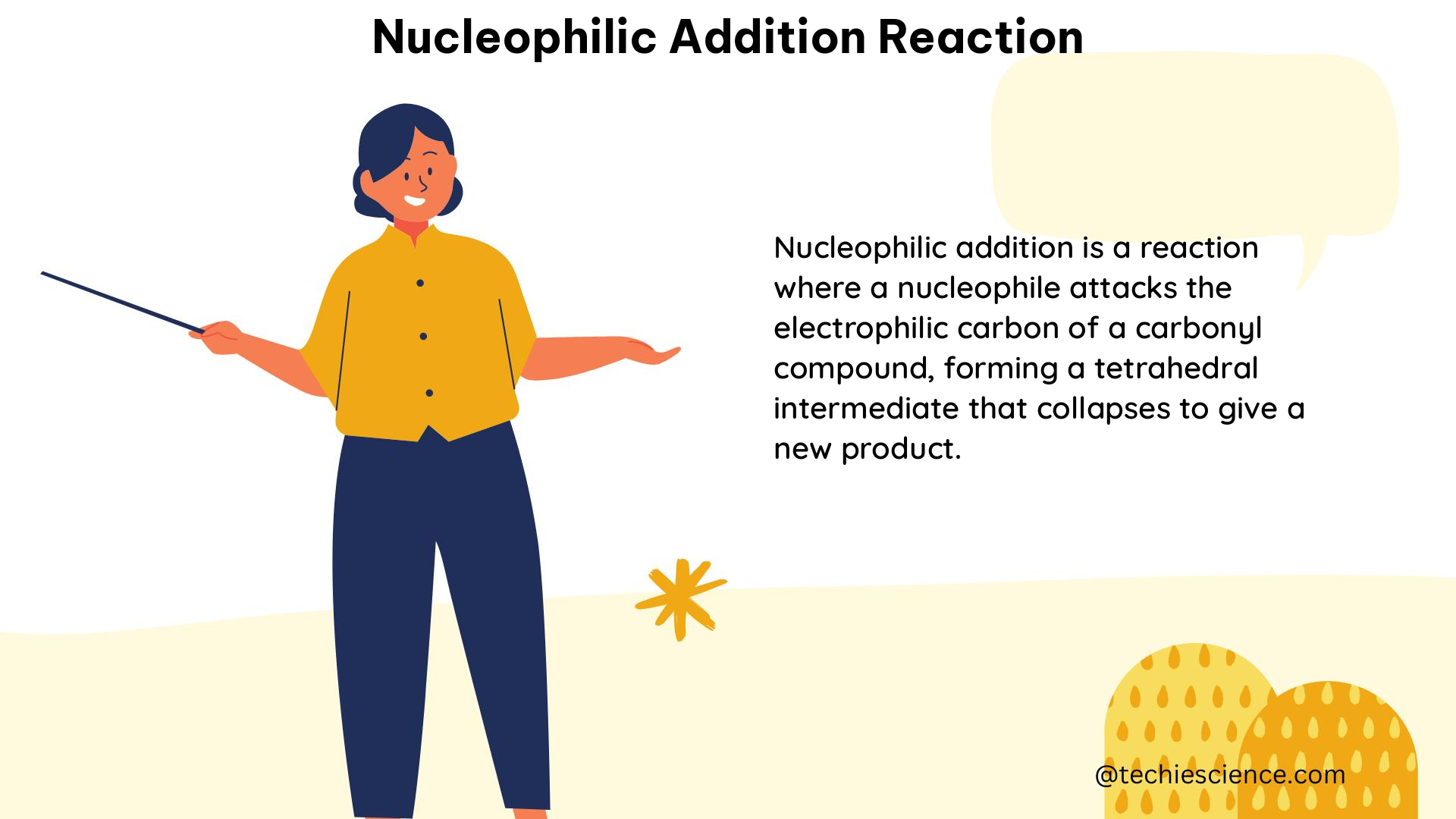Nucleophilic addition reactions are fundamental organic reactions involving the addition of a nucleophile (an electron-rich species) to a carbonyl group (a polar double bond with a slightly positive carbon center). These reactions are crucial in the synthesis of various organic compounds and have widespread applications in the field of organic chemistry.
Understanding the Mechanism of Nucleophilic Addition Reactions
Nucleophilic addition reactions can be classified into two main categories: those involving negatively charged nucleophiles and those involving neutral nucleophiles.
Negatively Charged Nucleophiles
For negatively charged nucleophiles, the mechanism generally involves the formation of a tetrahedral alkoxide intermediate after the initial attack of the nucleophile on the carbonyl carbon. The stereochemistry of these reactions is crucial, as the configuration of the new chiral center depends on which side of the carbonyl plane the nucleophile attacks from.
The mechanism can be represented as follows:
- The nucleophile (Nu-) attacks the carbonyl carbon, forming a tetrahedral alkoxide intermediate.
- The alkoxide intermediate can then be protonated, resulting in the formation of the final product.
The stereochemistry of the final product depends on the approach of the nucleophile. If the nucleophile attacks from the same side as the leaving group (e.g., a halide or alkoxide), the reaction is said to proceed with retention of configuration. If the nucleophile attacks from the opposite side, the reaction is said to proceed with inversion of configuration.
When the two groups adjacent to a carbonyl are not the same, the reaction can result in a racemic mixture of stereoisomers or favor one stereoisomer, depending on the structure of the reactants and the conditions under which the reaction takes place.
Neutral Nucleophiles
Neutral nucleophiles, on the other hand, form a C=Nu bond after the initial attack on the carbonyl carbon, with the carbonyl oxygen being completely removed as water. The mechanism can be represented as follows:
- The neutral nucleophile (Nu) attacks the carbonyl carbon.
- The carbonyl oxygen is removed as water, forming the final product with a C=Nu bond.
Factors Affecting the Reactivity of Aldehydes and Ketones

In general, aldehydes are more reactive than ketones due to the greater polarization of the carbonyl bond, which facilitates the nucleophilic attack. The relative reactivity of aldehydes and ketones can be influenced by the presence of electron-withdrawing or electron-donating groups on the carbonyl carbon or the nucleophile.
Electron-withdrawing groups on the carbonyl carbon increase the electrophilicity of the carbonyl carbon, making it more susceptible to nucleophilic attack. Conversely, electron-donating groups on the carbonyl carbon decrease the electrophilicity of the carbonyl carbon, reducing its reactivity.
The nature of the nucleophile also plays a role in the reactivity of the carbonyl compound. Stronger nucleophiles, such as alkoxides or Grignard reagents, are more reactive and can undergo nucleophilic addition reactions more readily than weaker nucleophiles, such as alcohols or amines.
Acid-Catalyzed Nucleophilic Addition Reactions
Acid-catalyzed nucleophilic addition reactions involve the conversion of less electrophilic carbonyl compounds to a more electrophilic form by protonating the oxygen, making it more susceptible to nucleophilic attack. The mechanism can be represented as follows:
- The carbonyl oxygen is protonated, forming a more electrophilic carbonyl carbon.
- The nucleophile attacks the more electrophilic carbonyl carbon, forming a tetrahedral intermediate.
- The tetrahedral intermediate is deprotonated, resulting in the final product.
Acid catalysts, such as hydrochloric acid (HCl) or sulfuric acid (H2SO4), can be used to facilitate these reactions by increasing the electrophilicity of the carbonyl carbon.
Quantifiable Data on Nucleophilic Addition Reactions
Nucleophilic addition reactions can be characterized by various quantifiable data, including:
- Reaction Rates: The rate at which the reaction proceeds, which can be influenced by factors such as temperature, solvent, and the nature of the reactants.
- Equilibrium Constants: The equilibrium constant (K) for the reaction, which provides information about the thermodynamic favorability of the reaction.
- Activation Energies: The energy barrier that must be overcome for the reaction to occur, which can be determined experimentally or computationally using techniques like Density Functional Theory (DFT).
For example, a DFT study on the nucleophilic addition reaction of diethylamine with 1-cyano-2-phenylvinyl methane sulfonate found that the reaction is exothermic (ΔH = -18.4 kcal/mol) and involves a transition state with significant charge separation, indicating a highly polar transition state.
Conclusion
Nucleophilic addition reactions are a fundamental class of organic reactions with widespread applications in the synthesis of various organic compounds. Understanding the mechanisms, factors affecting reactivity, and quantifiable data associated with these reactions is crucial for chemists and students in the field of organic chemistry. This comprehensive guide has provided a detailed exploration of the key aspects of nucleophilic addition reactions, equipping you with the necessary knowledge to navigate and excel in this important area of organic chemistry.
References:
- Morsch, B., Neuenschwander, G., & Staneck, J. (2024). Nucleophilic Addition Reactions of Aldehydes and Ketones. In Organic Chemistry (pp. 19-20). Chem.libretexts.org.
- Nucleophilic Addition – an overview | ScienceDirect Topics. (n.d.). ScienceDirect.
- Nucleophilic Addition Reactions – Chemistry LibreTexts. (n.d.). Chem.libretexts.org.
- Organic Chemistry Basic Questions and Answers – Sanfoundry. (n.d.). Sanfoundry.
- Reactivity and mechanism of nucleophilic addition reaction of amine with alkene: A systematic DFT study. (2019). ResearchGate.

The lambdageeks.com Core SME Team is a group of experienced subject matter experts from diverse scientific and technical fields including Physics, Chemistry, Technology,Electronics & Electrical Engineering, Automotive, Mechanical Engineering. Our team collaborates to create high-quality, well-researched articles on a wide range of science and technology topics for the lambdageeks.com website.
All Our Senior SME are having more than 7 Years of experience in the respective fields . They are either Working Industry Professionals or assocaited With different Universities. Refer Our Authors Page to get to know About our Core SMEs.